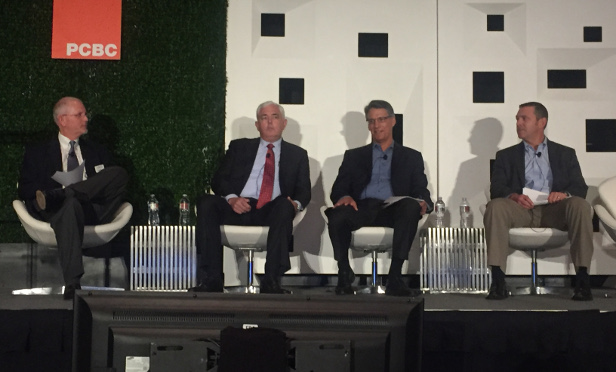
SAN DIEGO—Knowing what will work in which markets is key to developing a successful infill apartment community, and sticking with jurisdictions with which you are familiar can help, said speakers at PCBC here last week. During the panel session “Infill Insights—Getting Infill Deals Done,” moderator Pete Reeb, principal of John Burns Real Estate Consulting, said four out of 10 new-home projects in Southern California are infill; six out of 10 in Northern California.
Reeb said in answering the question “How do you determine achievable new home prices in infill deals when there are no good new-home comps?” it is possible and necessary to price new homes using resale comps. This is important because more new-home projects are being built in older infill neighborhoods, infill areas often have no new-home projects to use as comps, typically, there are plenty of resales and investors want to see proof of concept. Therefore, understanding the new vs. existing home-price relationship is critical for determining achievable prices for many new infill-housing projects.
Reeb said his firm typically considers at least 15 variables that can impact pricing:
- Type of sale (market, short, foreclosure)
- Date of sale and changing market conditions
- Timing in the “market cycle”
- Location vs. subject
- Setting and surrounding land uses
- Premiums (view, cul-de-sac, etc.)
- School performance
- Lot size and/or density
- Home size and price per square foot adjustment
- Parking spaces: type and number
- HOA dues
- Total tax rate (base plus additional taxes)
- Community amenities
- Builder reputation premium potential
- Product type (particularly for attached)
- Unit features (bathroom count, etc.)
- Was the resale recently remodeled
- Days on market prior to sale
One key finding was that the top five variables that impact achievable new home premiums are:
- Age of resales
- Marketing timing/cycle
- Quality of schools
- “Walkability” of neighborhoods
- Quality/type of adjacent uses
Jon Robertson, division president Southern California for William Lyon Homes, said his firm uses the acronym LOVE to formulate which infill sites it is going to analyze for development: L = location, targeting your markets; O = Others, expanding opportunities through local experts; V = Value, defining the value proposition you are capable of creating; and E = Emulate over Entrepreneurial, you don't have to invent to be successful. In determining supportable revenues, Robertson adapted the baseball acronym VORP (value over replacement player) to real estate terms by substituting “project” for “player.” Infill projects by nature mandate value creation, he said, and he cited several of his firm's projects as examples, including the Hawthorne, CA-based projects Hawthorne 360 and Townes @ 360 and Mackay Place in Cypress, CA. “You don't have to be everything to everybody,” said Robertson. “Trust but verify” and “There's no optimum market—you must build value constantly.”
Richard Douglass, division president of Trumark Homes, said in order to be successful at infill development, “You have to have the stomach for going through neighborhoods. The deal has to have lots of hair on it for us to consider it.” He gave the example of a 28-unit former office site in Costa Mesa, CA that backs up to a '70s-vintage commercial strip center. “We had to have four different price tiers, and the released the project en masse.” Douglass said that homebuyers are often cherry pickers—they have their eye on specific lots and won't move once they've decided on one. He added that parking is one issue for which developers should hire a consultant in order to get it right. “Solve yesterday's problem today with an eye to the future.”
Lastly, Brendan Hayes, SVP for the San Diego and Northern California regions at Fairfield Residential, said his firm had built in an area of San Diego that had been largely built out in the '60s. The freeway-adjacent topography held a challenge: a 50-ft. elevation change from the top of the project to the bottom. Hayes recommended looking for a highly visible site, lack of supply in the submarket and region and a desirable suburban submarket with increasing popularity and a substantial base of service amenities.
© 2025 ALM Global, LLC, All Rights Reserved. Request academic re-use from www.copyright.com. All other uses, submit a request to [email protected]. For more information visit Asset & Logo Licensing.








